- Abstract
- Text body
- Conclusion or Summary
- CV of the author and
- a photo of the author
Inside TRIZ
Idealized Supply Chain Design: Towards Ideality
- Published on October 15, 2021

Igniting Food Systems Revolution | Industry 4.0 Partner @ Cognizant
Five years ago, I came across an OODA loop model (observe-orient-decide-act) developed in the 1960ies by military strategist Air Force Colonel John Boyd to support fighter pilots and their decision-making tasks on the battlefield. Indeed, you might draw parallels with some modern frameworks, but this is not an objective here. What impressed me is his serious approach to assessing implications triggered by the second law of thermodynamics and its further impact on military strategy.
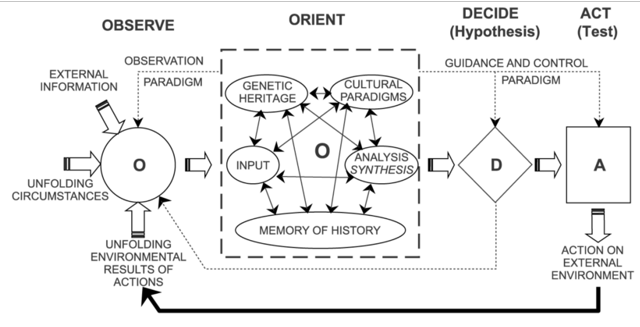
Boyd’s definition of the law was much more “user friendly” than the versions we usually find in the works of Kelvin, Plank, and others. He stated that:
“… entropy of any closed system always tends to increase and thus the nature of any given system continuously changes even as efforts are directed toward maintaining it in its original form.”

That was an exciting insight that stimulated my further thinking in the supply chain domain. Despite all efforts that we put in to control the flows, the environment continuously brings us even more challenging conditions. We try to impose even more control and organization over it. But how successfully?
I have not continued massaging this mental model too long, as my attention slipped to another point that this law highlights. Any organized system will continuously tend towards the increasing levels of entropy, at the same time, it always aims at minimizing its energy state. Well, the more we want to organize and control the system, the more energy we will spend on it, yes?
While incubating those cosmic thoughts, I felt like Don Quixote fighting with windmills in real life. The nature of supply chain challenges I had to orchestrate with my global team felt like solving fundamental contradictions rather than trade-offs that we historically managed across many industries. I had to build operating models that were both agile and lean, deliver superior service to the markets while meeting aggressive cost-cutting goals, activating efficiencies, and increasing the level of customized solutions. Contradictions.

How can we orchestrate supply chain contradictions? During my next jump into a mental rabbit hole, this is the question I was researching. One online statement captured my attention: “…every technical system aims to reach its maximum state of ideality — function is performed (or need is fulfilled), but there is no system”.
That made sense considering conclusions from the second law of thermodynamics and minimization of energy consumption made me pause. From that moment, my introduction with Genrich Altshuller started (founder of TRIZ) that later led to the definition of Idealized Supply Chain Design principles inspired by pieces of training and work of TRIZ Master Valery Souchkov.
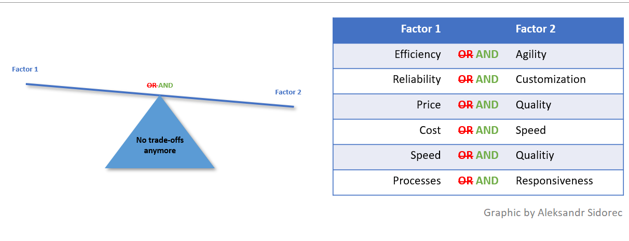
Let me first give you an initial overview of TRIZ itself.
TRIZ (translates from Russian as Theory of Inventive Problem Solving) had its starting point back in 1946 when Soviet inventor Genrich Altshuller and his colleagues ran research with thousands of patents. They discovered and coded specific patterns of technical systems’ evolution.
The main message is that evolution of a technical system is not a random process but is driven by specific regularities and has consistent patterns. These patterns can be used to consciously develop a system along its path of technical evolution and get to the breakthrough innovation by solving very complex problems in engineering. By that time, Altshuller and his students came with a definition of “contradictions” and developed frameworks that are helping to solve issues on the lowest levels of any technical system. Today technical TRIZ is actively applied in such companies as Samsung, Philips, LG Electronics, and many other names from the Fortune 500 list.
Since the 2000s, TRIZ had another evolutionary boost by actively expanding its application in other non-technical domains thanks to the passion and the drive of a tiny and dedicated group of professionals: in education, business, and software engineering. My kids are an excellent example as they participate in several training platforms that utilize TRIZ educational methods to bolster children’s creativity and systematic problem solving.
Let’s get to the basics now…
One of the core principles we will work with is the system’s ideality. As supply chains are engineered systems, those are architected to perform several functions. Based on the principle of ideality:
a perfect supply chain performs all the functions it was designed for without using any resources or creating any harm to itself, people, its product, the environment, or society.
In other terms: the consumer receives the product, but there is no supply chain behind it.
Any change in the supply chain that improves the performance of its designed functions or reduces the number of resources or the degree of harmful effects and waste will advance it towards ideality. Such a mental model is critical when we zoom out to the level of strategic planning and business / operating model architecture.
It is essential to note the focus is on the function and not the supply chain itself.
The operating model of the supply chain can be changed from the ground up as long as the new model meets its intended goals.
For instance, if we want to deliver a specific product to a consumer, we have several models at our disposal, each of which applies different operating principles:
‣ Product is packed and delivered by the courier to the consumer’s door
‣ Pack is picked by an autonomous vehicle and delivered to the destination
‣ Consumer downloads CAD technical drawing and prints the product at home
The delivery of the goods will be considered ideal when: the product appears in the right place, at the right time, and in the correct quantity without requiring any logistical system to get it to the consumer. Science Fiction? Not necessarily.
The objective of such a model is not to create a Space conquest strategy for the Supply Chain Management domain (although you might certainly discuss this idea with Elon Musk as he will need Space Logistics experts soon). Rather than move us outside of psychological inertia when we are trying to solve problems across the value chain in the same way others do. This barrier to innovation becomes even more critical when we intend to redesign the whole operating model of the enterprise to activate new levels of competitive advantage.

What often happens? We have a hammer, and we see the nails everywhere. As a result, we tend to solve problems or implement solutions based on predefined templates of models and behaviors instead of creating tailored and unique system structures relevant only to you, your company, and the particular context of the business.
Why is this important within the strategic layer of the supply chain model? Because technology becomes quickly obsolete and is becoming quickly commoditized, causing the problem that it is hard to build a competitive strategy just on this. Exciting potential lies in an intelligent blending of different elements to activate new capabilities and functions.
The best way to represent such a level of ideality through the simple formula that I have adopted from the works of Valery Souchkov:
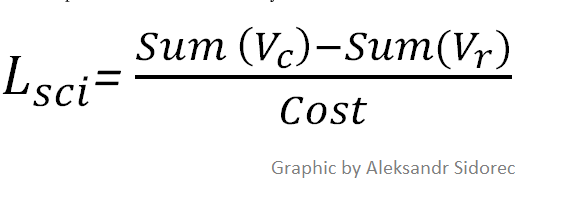
Li = Level of Supply Chain ideality
Vc = Value-creating factors (e.g., speed, flexibility, consumer satisfaction, etc.)
Vd = Value reducing factors (e.g., waste, environmental impact, long lead times, etc.)
Cost = all the costs associated with running and executing such a supply chain
The formula clearly states where our focus should be.
When discussing the topic of ideality, it is worth considering some of the trends related to the evolution of the technical system.
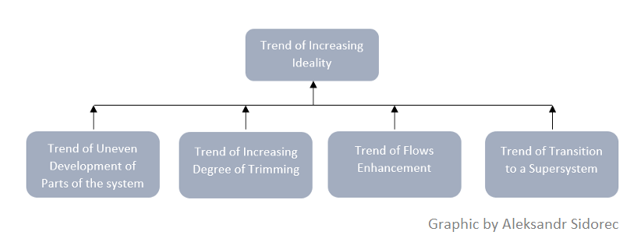
I have listed just a few examples that boost the state of the supply chain’s ideality. Still, we will have a deeper look into that in later publications considering that this forms an essential foundation when an organization sets an ambition to make a quantum leap in its business performance.
Before we deep dive into the some of those trends in the context of our daily operational realities, I should clarify some relevant definitions related to:
‣ Trimming
‣ Supersystem
Trimming in the supply chain. When applying the trimming process, we look for ways to reduce (to trim) some of the components involved in a specific supply chain activity. Their functions are redistributed amongst other (existing or improved) components. This process might lead to better operational costs, safety, and processing speed.
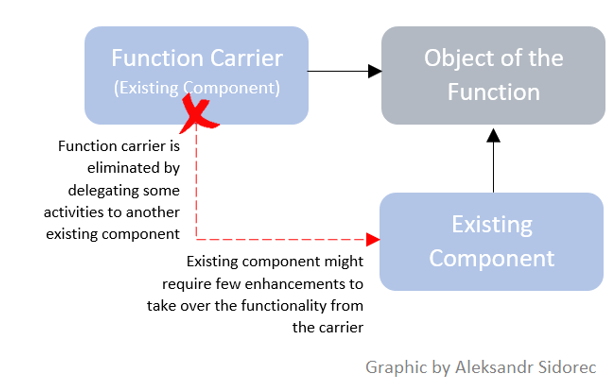
Let’s assume that based on functional analysis (analogue of process analysis/value stream mapping), we have identified a set of activities that are performed within a specific part of the supply chain. For example, and to provoke some out-of-box thinking, let’s look at the case of international container shipments causing many challenges today due to global imbalance on the freight markets.
The Core Elements of the ocean freight flow are the following:
Vessel — Container — Product
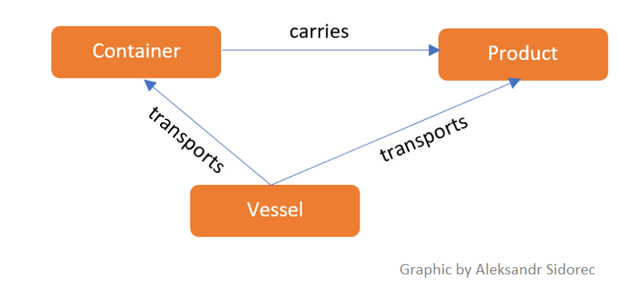
We know that a vessel’s availability is one of the factors currently causing adverse effects within our supply chain system. So, let’s take it out of the equation and delegate the transportation function to the container. So, the new system would be something like this:

Imagine the ocean full of self-sailing and navigating containers using electro-drive powered by solar energy.
Trimming is a powerful standalone tool that can help reduce costs across the value chain and should be used as collaborative work between procurement and technical functions. I will publish different material on this subject.
Supersystem of the supply chain. The supersystem is one of the core elements of the Idealised Supply Chain Design framework. The main point here is that the supply chain is not an isolated activity but a part of the specific supersystem that the company operates in.
Here I am going to extend the work of Valery Souchkov. He made a deep analysis of the supersystem within TRIZ by defining the key elements of the supersystem’s completeness:
‣ Supersystem as a source of resources for a supply chain system
‣ Supersystem as a driver of lifecycle within a supply chain system
‣ Supersystem as a means of control within a supply chain system
‣ Supersystem as a source of a target for a supply chain systems existence
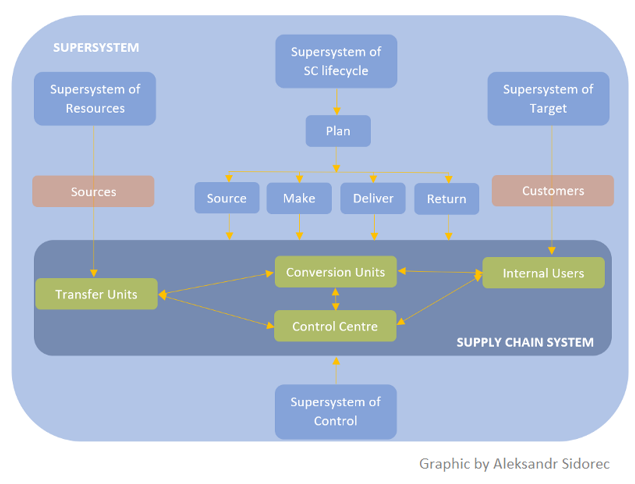
We can certainly draw a parallel between the supersystem and business ecosystem, which would be correct to a certain extent, considering there are elements mutually shared between both structures. In this context, a more correct view would be that the business ecosystem represents a sum of several supersystems that share common targets and objectives.
Now, here are some key elements related to our Supersystem:
🅐 Supersystem provides Resources necessary for Supply Chain System to execute its function and target. For example, it is possible to execute its function thanks to accessing the Sources = Vendors who are forming a critical part of the supersystem
🅑 Supersystem provides the Lifecycle of Supply Chain System, meaning that it provides everything necessary to ensure that various execution stages can be performed within the system. A minimum number of subsystems are available within a Supersystem to ensure that planning, sourcing, production, delivery, and returns can be executed. For example, in the case of Deliver stage, Supersystem provides an infrastructure (e.g., roads) that enables the execution of logistical function within the supply chain
🅒 Supersystem provides Control over the Supply Chain System that is activated thanks to the minimal number of subsystems within the Supersystem itself. For example, the driver operates the forklift in the warehouse, but the Warehouse Management System is used to guide the picking locations
🅓 Supersystem as a source of Supply Chain Systems Target provides a minimal number of subsystems necessary to ensure that the system effectively executes its primary purpose and function. For example, Supersystem provides the customers or consumers who have specific expectations related to the final product of such a system. Otherwise, the system would be supplying the goods to the markets that do not exist (previously I would joke regarding the supply of refrigerators to the North Pole, but with all the environmental challenges and temperature changes past 5 years, this might become a new reality)
Now we come to the Supply Chain System itself. It has a minimal viable structure (MVS) that usually includes Transfer Units, Conversion Units, Control Centre, and Internal Users. But in order not to overload this publication, I will skip details at this stage.
Let’s return to our conversation about the technical systems trends and their applicability within the supply chain domain.
Most interesting is that by combining the knowledge about such trends with S-curve analysis, we are well-positioned to forecast several scenarios about supply chain systems’ further development in the context of specific business activity. This knowledge gives us the means to design a long-term transformation roadmap for a specific operating model and its subsystems. But this should be performed in combination with trends of consumer behaviors evolution that we will analyze in another upcoming publication.
Why is this important? Idealized Supply Chain Design operates across several layers, each with its own set of tools and toolkits that could be applied to solve strategic, resource-based, and operational challenges within the supply chain.
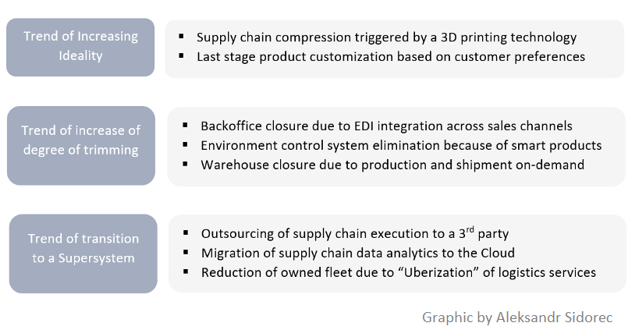
This information means that we will need to work from a strategic level. We are having a systematic look at the supply chain as a whole, including analyzing its subsystems and the current state of the supersystem. We do not want supply chain engineers and architects to implement the changes across the business value chain so that no supersystem can support this.
We do not need to go far away, for examples. We already have hydrogen-powered engines and cars available, but there is a lack of access to the fuel itself. Another example is when you develop automated warehouses for inbound cargo handling. Still, your supply base is not ready to adopt because of new palletization requirements so that you can have smooth warehousing operations and a low level of exceptions handling.
We move into resource management from the strategic level blended with processes and flows. Those are the layers where we usually start facing first contradictions that will not accept simple trade-offs but require a disciplined and structured work of resolving them. And that is where the miracle of idealized supply chain design begins.
This publication contains an introductory overview to give the reader a high-level understanding of some essential principles related to the Idealised Supply Chain Design. The following article will provide insights about the “soft” elements of the discipline — psychological inertia and role of abstractions, why those are important and relevant for supply chain practitioners.
Stay tuned. More to be published on the topic…
About the Author: Aleksandr is Advisory Partner Industry 4.0 @ Cognizant. He is on a mission of supporting clients across AgriFood, FMCG, and Retail sectors to accelerate value chain transformation boosted by the Internet of Things (IoT) and intelligent data leverage. Previously he spent 18 years shaping operational capabilities for the Fortune 500 companies: Olam International, Holcim, Johnson & Johnson, Caterpillar / Zeppelin, and Procter & Gamble.
He blends his professional activity with a personal exploration of startup ecosystems combined with research related to Lean Six Sigma, Inventive Problem Solving (TRIZ), and Systems Engineering to activate solutions for the most challenging issues across the supply chain domain.
More information: www.sidorec.com
Idealized Supply Chain Design (ISCD) by Aleksandr Sidorec is licensed under a Creative Commons Attribution-NonCommercial-NoDerivatives 4.0 International License
